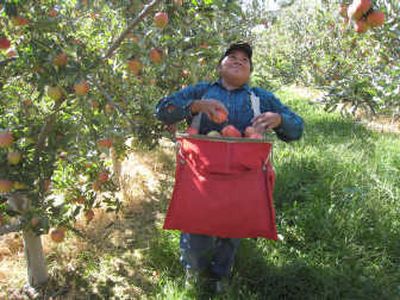Forecasting change in the fields

BENTON CITY, Wash. – Tom Judkins Jr.’s grape-growing experience began with just a few backyard vines when he was 16 years old.
Some 40 years later, his 100-acre nursery produces more than 3 million grape vine cuttings in the lower Yakima Valley. The tender plants have fed a boom in Washington’s wine industry, which boasts 500 wineries and 31,000 acres of wine grapes.
Judkins admits he’s wondered when that growth will slow. “Five years ago, I kept saying, ‘Is this peak going to happen?’ And each year, I keep seeing more and more interest,” he said.
That peak could still be a ways off. As the region prepares for the possibility of warmer temperatures and reduced snowpack resulting from climate change, more growers could be moved to plant a crop that requires less water while meeting consumers’ thirst for fine wine.
And while wine grapes aren’t Washington’s biggest or most valuable crop, they may be emblematic of how changes in climate could have both positive and negative effects on Washington’s $6.4 billion agriculture industry.
Debate continues about causes and possible effects of climate change or even if it really exists. But scientists at the University of Washington’s Climate Impacts Group for years have studied what global warming could mean for the state: a half-degree temperature increase each decade, on average; an earlier onset of warmer temperatures each spring; a decline in snowpack, particularly at low and middle elevations, with more rainfall in the winter instead.
The potential effects on agriculture vary.
Warmer temperatures can stress livestock, reducing production in dairy herds, and burn fruit and other crops. Bugs and diseases that survive if temperatures don’t drop enough in the winter could become a concern, particularly for organic growers who don’t use pesticides.
At the same time, elevated levels of carbon dioxide generally increase sizes and yields of some crops.
More rainfall in the winter would raise the potential for flooding west of the Cascades. Less snowpack or an earlier thaw would mean less water for irrigation in the dry eastern half of the state during the summer and early fall.
Some projections also show a decline in precipitation in general, which could hurt dryland crops that already receive little moisture. But longer growing seasons could allow growers to plant new crops and varieties that flourish under different conditions.
Central to the debate in Washington state is water. West of the Cascades, only 58,434 acres are in irrigated agriculture. East of the mountains, it’s a different story, where some 1.6 million acres produce a cornucopia of crops – tree fruits, hops, grains and vegetables, hay and alfalfa feed for livestock.
According to a 2005 study by researchers at Pacific Northwest National Laboratory, the likelihood of severe drought conditions in the Yakima Valley increases to one out of every two years by the middle of the century as the region warms.
That concerns Mario Mosso, a 41-year-old fruit grower in Wapato, who saw his water supply halved during the 2005 drought. Apples, apricots, peaches and pears didn’t develop as they should have, and his trees yielded 20 percent less fruit, cutting his income in half.
“I recognize that water is not going to be there forever and there’s changes that we’ll have to make,” Mosso said, pointing to a sprinkler system he’d like to replace with more a more efficient, and more expensive, drip system.
But assuming that Washington’s water supply doesn’t dry up, the state should be in a good position to compete globally in agricultural markets, said Thomas Wahl, director of Washington State University’s IMPACT Center, the international marketing program for agricultural commodities and trade.
Of course, agricultural markets also depend on what’s happening elsewhere in the world. For example, growers in China have been shifting production to higher altitudes to produce better apples, he said. Wine grape growers in Spain have been doing the same thing. In Australia, citrus trees are being replaced with wine grapes to conserve water.
Some reports have even questioned the viability of California’s wine crops amid rising temperatures.
Researchers disagree over whether Washington could supplant it as the nation’s top wine region, but they agree on one thing: Wine grape acreage in Washington could increase if water gets short.
“There clearly could be more growth in Washington, especially if water and the infrastructure for water does not become more available,” said Greg Jones, professor in Southern Oregon University’s environmental studies department.
Judkins, the nurseryman and orchard owner, noted that plenty of growers have pulled up their fruit trees to plant grapes. He hasn’t, but surrounding his orchards are acres of vineyards.
“It does seem like more often, we’re having short water years,” he said. “Whether that’s climate change or not, I don’t know, but I think maybe wine grapes, for a crop to grow, as a grower it’s a good choice.”